After ten years of integration, how will Cisco respond to first-tier telecommunications equipment manufacturers?
The transition from mobile networks to all-IP networks provides fixed IP vendors like Cisco with business opportunities to target the growing area of ​​mobile networks. At the same time, Ericsson, Alcatel-Lucent, Huawei and Nokia Siemens and other leading telecommunications equipment manufacturers (TEM) are committed to developing internal IP technology and service platforms. Now, in order to compete for market share, direct competition between IP providers and telecommunications equipment manufacturers, which are also major providers of next-generation mobile IP infrastructure, will increase.
Service providers have always relied on telecom equipment manufacturers to design and integrate complete solutions so that they can gain an advantage in competing with certain small providers that provide specialized network elements. Cisco has played the role of a major supplier in the IP field of service providers. After internal product development and the acquisition of Starent, Cariden, Broadhop and Intucell, Cisco has become a major supplier in the mobile network field. Earlier, Cisco stated that Intucell can optimize heterogeneous network management (HetNets) by optimizing operators' existing macro wireless signals and dynamically integrating new small cells (third parties) into macro networks. Cisco's series of actions enable it to support multi-vendor mobile all-IP infrastructure.
Complete the last puzzle, the next challenge is to integrate
Over the past 10 years, Cisco has continued to build and acquire components of mobile network infrastructure. The Radio Access Network (RAN) is a missing segment of the Cisco solution. The transition to the next-generation mobile network architecture has opened a door for Cisco to fully penetrate the end-to-end (E2E) mobile infrastructure.
Cisco's announcement on April 3 that it acquired Ubiquisys means that the company's mobile network product portfolio is close to complete and has entered the mainstream of 4G RAN. Ubiquisys may be the last part of Cisco's mobile infrastructure layout and a key part of supporting the next generation mobile wireless access network architecture.

Whether all Cisco acquisitions can be effectively integrated to support its competition with Alcatel-Lucent, Ericsson, Huawei, and Nokia Siemens in the small cell or end-to-end field, and we need to wait and see. . Some experts believe that the primary purpose of the acquisition of Ubiquisys is to create a "neutral mobile host" to provide integrated broadband access for BYODs in corporate offices, hotels, and public spaces.
Telecom equipment manufacturers should view Cisco as a direct competitor, especially threatened enterprises and Internet services. As mobile infrastructure spending dominates the budget, Cisco ’s original core and edge router business is gradually being challenged by telecommunications equipment manufacturers, and to a certain extent, it has actively responded to the threats faced by its core router business.
Aerial Insulated Cables Within Rated Voltage Up To Including 0.6/1KV
1. Product standard
The product is manufactured according to the standards of GB12527-90 [Aerial insulated cables of rated voltages up to and including 1KV" and IEC60502 [Extruded solid dielectric power cables for rated voltage from 1KV to 30KV" .
2. Operating characteristics
a. Rated voltage U0/U: 0.6/1kV
b. Max.permissible continuous temperature:
PVC.PE insulated aerial cables:70℃
XLPE insulated aerial cables:90℃
c. Max. short-circuit temperature of the conductor shall not exceed:
PVC insulated aerial cables:160℃;
PE insulated aerial cables:130℃;
XLPE insulated aerial cables:250℃.
d. The installation ambient temperature should not below -20℃.
The bending radiuses of cables are recommended as follows:
When the diameter of cables less than 25mm: not less than 4 times the diameter of cables;
When the diameter of cables not less than 25mm: not less than 6 times the diameter of cables.
e. When the cables use in alternating current system, rated voltage of cables should be at least equal the rated voltage of the system; When the cables use in direct current system, rated voltage should be not greater than 1.5 times of the rated voltage of the cables.
3. Type of cables and main usage
Type of cable:
JKV: Copper conductor PVC insulated aerial cables
JKLV: Aluminum conductor PVC insulated aerial cables
JKY: Copper conductor PE insulated aerial cables
JKLY: Aluminum conductor PE insulated aerial cables
JKYJ: Copper conductor XLPE insulated aerial cables
JKLGV: ACSR conductor PVC insulated aerial cables
JKLGY: ACSR conductor PE insulated aerial cables
JKLGYJ: ACSR conductor XLPE insulated aerial cables
Main usage:
The cables fit for overhead fixed-installation, service line and so on.
4. Construction of cable
1) Conductor
2) Steel core
3) Insulation
4) Conducor screen
Steel ACSR Power Cable,Hot Dip Galvanized Power Cable,Conductor Power Cable,Overhead Power Cable
Huayuan Gaoke Cable Co.,Ltd. , https://www.bjhygkcable.com